Outstanding in their field
The range of architectural signage that can be produced using both modern technology and traditional techniques, often in combination, is wide ranging from regular totem signs to stunning one-off specialist pieces that stop passers-by in their tracks or, at the very least, make them pause to take a second look or read the information provided.
Maritime reflections
Award-winning sign and graphics company, Castleton Signs, based in London, has been creating signs for over 70 years and offers a full consultancy, design, and manufacturing service throughout the UK.
“Our experience and technical expertise enables us to handle any type, size, or complexity of sign application, from one-off specialist projects to large-scale installations,” says managing director, Rob Winterborn.
One example of the specialist projects that Castleton Signs undertakes was a commission to develop, manufacture, and install the architect designed anodised aluminium and bronze wayfinding scheme at The University of Southampton’s 4.3-hectare Boldrewood Innovation Campus. The centrepiece of the scheme was the main campus entrance sign, weighing three-quarters of a ton, constructed from bronze with stainless steel lettering.
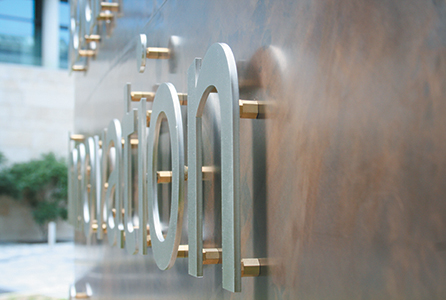
The feature entrance sign created by Castleton Signs for The University of Southampton features 5mm laser-cut brushed stainless steel text fitted to the face
“The new campus was redeveloped to incorporate the Maritime and Engineering Centres of Excellence, uniting the university with Lloyd’s Register of Shipping as the UK’s largest university-business partnership, thereby placing the university at the forefront of maritime research,” Winterborn explains, adding: “The scheme was, therefore, expected to reflect the high quality and innovative maritime theme, as well as unite the Lloyds building in a seamless way.”
Following consultation with architects Grimshaws, main contractors Wates, and Southampton University regarding materials specification, fabrication method, and logistics of locations/installation, Castleton worked the architect’s concept into a design that complemented and enhanced the environment whilst maintaining structural integrity, practicality, and future-proofing.
Keeping in line with the centre of excellence and maritime theme, anodised aluminium and bronze were used to enhance the environment and create longevity required.
Winterborn says: “The materials selected were contemporary in style and completely enhanced the architectural surroundings. Anodising permits a strong contemporary finish with incomparable corrosion, abrasion, and UV resistance—vital for metal parts that need to withstand the rigors of a marine environment.

Anodising permits a strong contemporary finish with incomparable corrosion, abrasion, and UV resistance”
“The main entrance feature sign is the highlight of the project from both a wayfinding and architectural perspective. It stands 2.5m tall and 2m wide, weighs three-quarters of a ton, and is set on a solid stone plinth of 200mm depth.”
It incorporates 3mm bronze panels to the front and back, 1.5mm fabricated bronze panels to the sides, top, and bottom, and 40 x 40mm box section framework to hold bronze panels, with 5mm laser-cut brushed stainless steel text fitted to the face.
As the sign was constructed in bronze, the framework, which sits on a 200mm deep plinth, had to be carefully constructed to cope with the three-quarters of a ton weight and wind load on the 2.5 x 2m panels. The thickness of bronze was, therefore, alternated to keep the weight down and the structure solid. As a final aesthetic touch to give the impression of a floating panel, a 3mm shadow gap was implemented around the face of the sign.
All signage for the scheme was designed, produced, manufactured, and installed by Castleton’s in-house team and the entire scheme was fabricated and installed within a tight six-week turnaround in time for a Royal opening.
Complex challenges
Flintshire company Is Group has been creating branding solutions for 35 years, designing, manufacturing, and installing signage schemes nationwide.
“Our reputation is built on creativity, quality, and innovation,” comments managing director, Jane Whitehouse, adding: “Trailblazing new technology, materials, and products, we deliver an expert sign service for all sectors that creates real impact. We’ve won awards for our architectural signs and enjoy solving complex manufacturing challenges.”
Two unusual projects that have been delivered by Is Group are the two new entrance signs at Alderley Park, and interpretation and wayfinding signage for the Pennine section of the Rochdale Canal.
“Place making consultants, Placemarque, with whom we have worked on a number of previous projects, gave us the opportunity to really flex our technical and logistical muscles when they approached us to turn an idea developed by leading brand agency The Chase for two new entrance signs at Alderley Park into reality,” says Whitehouse.
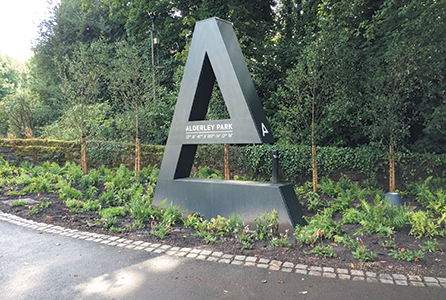
A technological and logistical challenge, this entrance sign is one of two visual representations of Alderley Park’s new brand mark created by Is Group
The entrance plans involved creating two visual representations of the Park’s new brand mark—one a 2.4m reinforced re-case concrete sculpture and the other a 3.5m illuminated aluminium structure.
A technical and logistical challenge, the 2.4m reinforced re-case concrete version of the brand mark was finished in Portland Stone and features internal steel reinforcement.
The moulds were produced and encapsulated into the main body of the mould in line with brand guidelines. Once the concrete was cured and removed from the mould, laser cut painted stainless steel letters were bonded into the recess to create a strong contrast against the Portland Stone finished body of the monument. A leading BBA certified protective coating was also applied to the concrete to seal and repel water and the onset of algae.
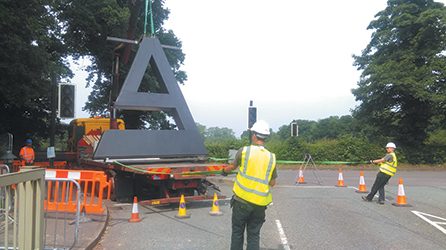
The entrance signs for Alderley Park were transported to site, using hi-ab vehicles, where Is Group’s installers had prepared the sites for delivery of the impressive feature signs
The complex project was completed in just seven weeks, with concrete moulding taking three weeks, the casting one week and the curing, which included the hardening of the reinforced concrete and application of the protective coating, taking just three weeks.
For the aluminium brand mark structure, Is Group’s team of coded welders fabricated a bespoke cantilever structure, using an internal steel framework to BSEN 1090-2 standard. A series of aluminium top hats provided the tolerance needed to clad the framework with powder coated interlocking aluminium panels.
The face and return profile of the structure displays the fret cut, flush finished Alderley Park name, which is internally illuminated using Sloan LEDs.
“These LEDs were selected as they offer enhanced life expectancy, giving the client further confidence in the quality of products selected by Is Group’s experts,” explains Whitehouse.
Once ready, both structures were transported to site, using hi-ab vehicles, where Is Group’s experienced team of installers had prepared the sites for delivery of the impressive feature signs. The two-tonne concrete sculpture was installed onto a precast concrete foundation that was designed and fully approved by structural engineers.
Group head of marketing at Bruntwood, owners of Alderley Park with Manchester Science Partnerships, comments: “We are delighted with the quality of finish on both structures. To see the vision of the ‘A’ brand mark, created by Steve Royle at The Chase, come to life is incredible. A special thank you to Placemarque for developing a creative design strategy and Is Group for a professional delivery on what was a complex and technical challenge.”
For the Rochdale Canal project, the brief from Imagemakers/ Calderdale Council was to manufacture and install new interpretation and wayfinding signage for the South Pennine section of the canal to ensure the history of the Rochdale Canal was brought to life with a number of interpretation features.
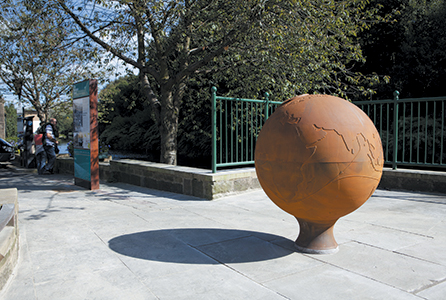
Is Group’s brief was to manufacture and install new interpretation and wayfinding signage for Rochdale Canal
The South Pennines lead project manager at Calderdale Council outlines the project: “The interpretation installations comprise cast iron sculptural elements sitting alongside high-quality totem signs. The idea is that the sculptural element introduces the story that unfolds on the totem, each totem telling a different part of the Canal’s social and economic history.

The idea is that the sculptural element introduces the story that unfolds on the totem, each totem telling a different part of the Canal’s social and economic history”
“The scheme was designed by leading Interpretation consultants Imagemakers and, following consultation, Is Group was appointed to manufacture and install the signage scheme due to our technical ability to understand the brief and our suggestions to overcome the requirements of the project which involved working with corton steel,” explains Whitehouse, adding: “We worked closely with Imagemakers with regard to specification and material durability taking into account the harsh outdoor environment.”
Signage consisted of primary hubs to link the town with the canals, and these were manufactured from aluminium and steel with printed vitreous panels inserted within the framework, with corton steel edging strips to the exterior framework. This required precise technical drawings from Is Group and a close working relationship with a specialist foundry (Halifax-based Hargreaves Foundry), sourced by the Is Group, to ensure all elements fitted.
In addition to the forming manufactured by Is Group, the foundry also manufactured the feature corton steel cast world globe and secondary wayfinding hubs, milepost signs, and towpath ribbons installed into the ground, indicating distances and timescales to various places of interest.
To create the globe (see next page) a CAD 3D model was generated by Is Group’s technical designer from flat 2D artwork received from the client. This was then used by the foundry to manufacture a multi-section mould for casting. The globe was cast in three sections and assembled onsite onto an internal steel frame.
The interpretation strips feature Lock 39 and Watershed. Lock 39, a four section casting with relief lettering, and finished with granite setts, contains historical facts regarding Rochdale Canal.
The one piece casting, Watershed, is a distinctive hump back shape with extension pieces indicating the direction of the North Sea and the Irish Sea. Its location marks the highest point of the canal in its journey over the Pennines and thus is at its watershed. In creating this, Is Group worked closely with the foundry on optimising weight, due to installation restrictions.
Customer satisfaction is quite clear, as the South Pennines lead project manager at Calderdale Council summarises: “Pennine Prospects has been very pleased to work with Is Group on the installation of some unique canal interpretation features on the Rochdale Canal in the South Pennines as part of its Canal Connections. We have found the quality of the design and installation service provided to be of a very high standard.”
“Few projects go smoothly and this one was no exception; when one of the sites was hit by flooding in the South Pennines, Is Group responded sensitively and flexibly to the resulting problems,” he adds.
Great and the good
Over the past 30 years Surrey based Signbox has delivered award-winning visual communication strategies via both traditional and pioneering signage methods across a number of market sectors, including corporate, education, healthcare, retail, hotel, and leisure.
As well as traditional signage applications, Signbox’s offering includes fabricated external structures, digitally printed glazing manifestations and wallpapers, wayfinding signage, digital signage, LED infused glass structures, contemporary name plates, interactive print via Near Field Communication (NFC), and signposting, among many others.
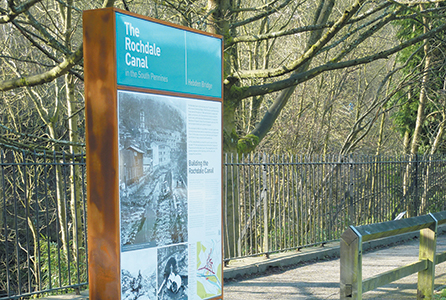
Wayfinding totem signage created by Is Group for the Rochdale Canal in the South Pennines consisted of primary hubs to link the town with the canals
“With a proven formula based on contemporary design, technical innovation, and engineering excellence, our holistic approach continues to put Signbox at the forefront of architectural signage,” notes managing director, Mark Bartlett.
He continues: “Sourcing and implementing cutting edge technologies and high-quality sustainable materials, the company is renowned for delivering powerful interior and exterior signage projects for a diverse range of global brands in the UK, Europe, the Americas, and the Far East—all of which are compliant, future-proof, and visually arresting.”
Signage for the world’s most famous police headquarters, New Scotland Yard, is among the many high profile contracts undertaken by Signbox.
When the Metropolitan Police Service relocated from London’s St James’s Park to Victoria Embankment in late 2016, Signbox was tasked with replacing the iconic sign that had been seen steadily rotating outside the St James’s Park building, and on television screens around the world, since 1968. In addition, contractors BAM also appointed Signbox to design and install bespoke brushed stainless steel lettering for the new building’s pavilion roof at the entrance.
“For such high profile signage, everything had to be designed and engineered to exacting detail,” Signbox senior project manager, Andy Harris, explains, adding: “We were conscious from the very start of the tender process that this was a project in which attention to detail was going to be especially important. The iconic rotating sign itself also posed huge challenges. We were tasked with creating a sign that could be illuminated at night, so simply copying the original design was not an option. In order to avoid tangled wires we used a slip ring mechanism, similar to those used in wind turbines.”
As well as being built to a very specific design, the sign needed to be highly robust and durable. The ball bearing, on which the sign turns, is strong enough to bear the weight of a car, the face panel is anodised for durability and the frame is stainless steel. For easy ongoing maintenance of the 0.37kw 6 pole TECA motor, the FRN33 parallel helical gearbox, and the electrics, an access panel was water jet cut into the frame. Months of rigorous testing for mechanical reliability and structural integrity took place before the 700 kilogram sign was ready to be transported to its new home and lifted into place by crane. Precision engineered stainless steel lettering, with blended edges, spells out the famous name, and the sign rotates at an optimal speed, calculated to fractions of a second to avoid blurring or distortion on television screens.
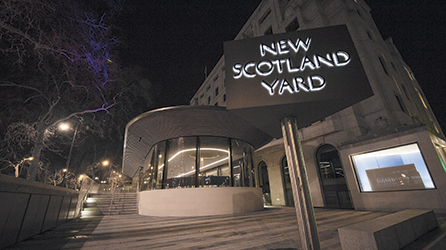
The iconic rotating sign for New Scotland Yard’s new Victoria Embankment location posed huge challenges for Signbox, as creating a sign that could be illuminated at night meant that copying the original design was not an option
The pavilion lettering posed a unique set of challenges of its own. Harris says: “The lettering needed to be visible to pedestrians at street level. So we installed each individual letter on a steel support rod to give the sign just enough height above the canopy for the bottoms of the letters to be visible, while at the same time minimising how much of each support rod was on display. Furthermore, the bracketry detail was created to precise specifications, in close consultation with the architects, in order to minimise how much was visible to people looking out, and down, from within the building itself. The stability and durability of the pavilion signage was also an important consideration, particularly how it would fare in strong winds.
“Overall, it was a hugely challenging, but rewarding project to be involved with. Being tasked with re-creating one of the most familiar and iconic signs in the world was a big responsibility and I’m immensely proud of the standard to which we delivered what was required of us.”

Being tasked with re-creating one of the most familiar and iconic signs in the world was a big responsibility and I’m immensely proud of the standard to which we delivered what was required of us”
Tom Wells, senior architect at AHMM, had high praise for Signbox’s contribution: “It was a pleasure to work with Andy Harris and his team on the New Scotland Yard project. Signage was an important part of the Metropolitan Police’s identity in their new riverside location and Signbox demonstrated the skill and teamwork required to overcome technical challenges and deliver a quality end product. Their enhanced replica of the iconic revolving sign will continue to form an important backdrop for media broadcasting (and tourist selfies), while the glowing lettering in Flaxman font they produced and installed on the pavilion roof will be a continual reminder to Londoners of the 24/7 nature of policing the capital.”
Not all Signbox’s projects are on such a grand scale or involve such famous names, but are equally as stunning in their own right.
A good example of these smaller scale projects is the bespoke brass-effect tenant directory sign for a prestigious office building at 12 Arthur Street, near London Bridge, which currently lists Prudential and AM Best among its tenants. The project formed a key part of the extensive refurbishment to the reception and lift lobby.
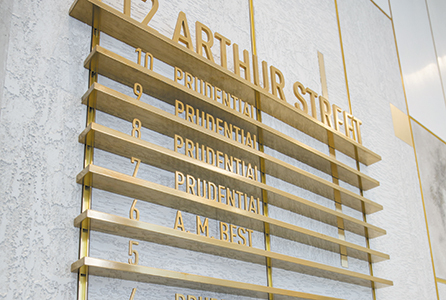
An example of smaller scale projects undertaken by Signbox is the bespoke brass-effect tenant directory sign for a prestigious office building at 12 Arthur Street, near London Bridge
Signbox manufactured the directory sign in-house on a Tekcel EXR router using 20mm thick acrylic and 6mm thick aluminium. The sign components were finished with a tarnished brass metal effect.
“This is a revolutionary process that applies a veneer of a metal coating to the surface and gives the look and feel of solid metal,” explains Bartlett, adding: “The Metall-FX manufacturing process involves artisan hand-finishing, polishing, and painting multiple layers to achieve the appearance of aged brass, matching other architectural details in the build.”
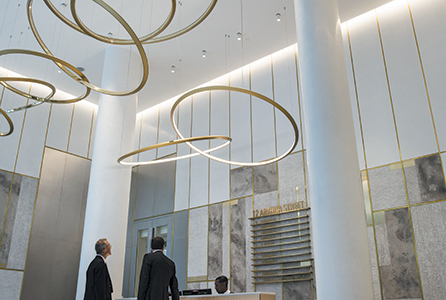
The Metall-FX manufacturing process used by Signbox involves
artisan hand-finishing, polishing, and painting multiple layers to
achieve the appearance of aged brass
The surface edges of the sign were bevelled with a pencil round router bit and sanded to a specific grit finish to achieve the optimum surface. Though it was time-consuming, the weight and cost savings over traditional brass fabrication were considerable.
Bartlett elaborates: “The architects on the project, Morrow and Lorraine, had originally requested a solid metal fabrication that would have been very expensive to produce. With our extensive experience of manufacturing techniques, we were able to value engineer the design, presenting an alternative proposal which offered significant cost savings to the client. We also worked closely with the specialist concrete cladding contractor, Graphic Relief, in order to facilitate a first fix of the support channels to secure the directory to the wall behind reception,” he continues.
“Having worked with Kingly Developments on a number of high-profile projects over the years, we were delighted to team up with them again on this project and, together with the architects and other specialist contractors, deliver a finished product that met all of the client’s expectations, while also coming in under budget,” adds Bartlett.
O Factoid: Totem poles, typically carved from the trunks of giant cedar trees, serve as important illustrations of family lineage and the cultural heritage of the Native peoples in the islands and coastal areas of North America’s Pacific Northwest (Wikipedia). O
Daniel Hall, associate at Morrow and Lorraine Architects, comments: “Working with Signbox on the brass effect tenant directory for 12 Arthur Street has been a real success. We have developed a good rapport through the period of design development, and have been impressed with their ability to advise on finishes and manufacturing processes that respond to the brief, ensuring the product was delivered on programme and within budget.”
As demonstrated by these examples, whether great or small, one-off and specialist architectural signage can make a huge impression, whether it is branding, informational or wayfinding.
Your text here...